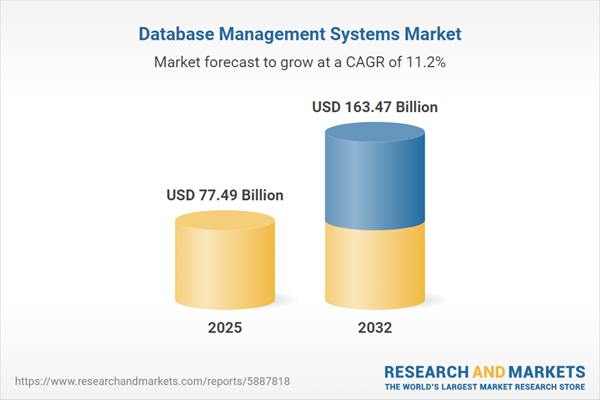Speak directly to the analyst to clarify any post sales queries you may have.
As global enterprises accelerate digital transformation, database management systems (DBMS) have become critical to seamless operations, real-time analytics, and competitive growth strategies. The Database Management Systems Market is evolving rapidly as organizations adapt to new sources of data and shifting technology landscapes.
Market Snapshot: Database Management Systems Market Size & Growth
The Database Management Systems Market grew from USD 70.04 billion in 2024 to USD 77.49 billion in 2025. It is expected to continue growing at a CAGR of 11.17%, reaching USD 163.47 billion by 2032.
Scope & Segmentation of the Database Management Systems Market
This report offers a comprehensive analysis of the database management systems market across multiple segmentation parameters and geographies. Key segmentations include:
- Database Types: In-memory, NewSQL, NoSQL (columnar, document-oriented, graph-based), and relational databases
- Pricing Models: License-based, subscription-based, and usage-based
- Technological Integrations: Artificial intelligence, big data analytics, blockchain, and machine learning (reinforcement, supervised, unsupervised)
- Deployment Models: Cloud and on-premises
- Organization Sizes: Large enterprises, small and medium enterprises
- Applications: Data processing and management, storage, and warehousing
- End Users: BFSI (corporate, investment, retail banking), education, government, healthcare (clinics, hospitals, research laboratories), IT and telecommunication, manufacturing, media, and entertainment
- Regions: Americas (United States, Canada, Mexico, Brazil, Argentina, Chile, Colombia, Peru), Europe, Middle East & Africa (UK, Germany, France, Russia, Italy, Spain, Netherlands, Sweden, Poland, Switzerland, UAE, Saudi Arabia, Qatar, Turkey, Israel, South Africa, Nigeria, Egypt, Kenya), Asia-Pacific (China, India, Japan, Australia, South Korea, Indonesia, Thailand, Malaysia, Singapore, Taiwan)
- Key Players: Industry leaders and innovators such as Altibase Corp., Amazon Web Services, Cloudera, Couchbase, Datadog, Google LLC, IBM, Microsoft, MongoDB, Oracle, SAP, Salesforce, Snowflake, Teradata, and others
Key Takeaways for Senior Decision-Makers
- Organizations face the challenge of uniting traditional relational databases with advanced NoSQL and NewSQL solutions, optimizing for both performance and flexibility.
- Cloud technologies and edge computing are driving strategic changes in deployment, requiring new approaches to security, governance, and regulatory compliance.
- Integration of AI and machine learning is increasing system autonomy, reducing manual administration and supporting intelligent decision-making.
- Diversified pricing and licensing, including subscription and usage-based models, are aligning costs more closely with workload and scaling requirements.
- Innovative partnerships among vendors, cloud providers, and hardware manufacturers are fostering resilience in the face of global trade and supply chain shifts.
United States Tariff Impact on Database Management Supply Chains
Recent tariff measures in the US have raised costs for key hardware components, prompting industry players to seek alternative sourcing and recalibrate vendor relationships. Software providers are adapting pricing models to sustain value, while R&D partnerships are increasingly structured to reduce risks associated with trade policy changes. These trends underscore the growing importance of total cost analysis and strategic supplier management in database system investments.
Database Management Systems Market Methodology & Data Sources
This report utilizes a multi-dimensional research framework, combining desk research, primary interviews with database architects and IT executives, and detailed analysis of technical literature and vendor documentation. Cross-verification through expert panels and advanced analytics ensures accuracy and relevance. Scenario planning further strengthens the robustness of conclusions, particularly regarding external influences such as regulatory changes and tariffs.
Why This Report Matters for Enterprise Strategy
- Gain a holistic view of the database management systems market, including new database types, cloud strategies, and integration of advanced analytics and AI capabilities.
- Understand vendor differentiation and emerging partnership models that enable risk mitigation, scalability, and compliance in various industry contexts.
- Leverage actionable recommendations tailored to support digital transformation initiatives and operational resilience in dynamic markets.
Conclusion
The database management systems market is defined by rapid innovation, evolving deployment models, and a blend of strategic partnerships. Senior leaders who align technology adoption with operational and regulatory realities will be best positioned to drive future business growth and maintain competitive advantage.
Additional Product Information:
- Purchase of this report includes 1 year online access with quarterly updates.
- This report can be updated on request. Please contact our Customer Experience team using the Ask a Question widget on our website.
Table of Contents
3. Executive Summary
4. Market Overview
7. Cumulative Impact of Artificial Intelligence 2025
Companies Mentioned
The companies profiled in this Database Management Systems market report include:- Altibase Corp.
- Amazon Web Services, Inc.
- Cloudera, Inc.
- Couchbase, Inc.
- Datadog, Inc.
- DbVis Software AB
- ForeSoft Corporation
- Google LLC
- Idera, Inc.
- International Business Machines Corporation
- JFrog Ltd.
- MariaDB Foundation
- Microsoft Corporation
- MongoDB, Inc.
- Neo4j, Inc.
- Oracle Corporation
- PremiumSoft CyberTech Ltd.
- Quest Software Inc.
- Redis Ltd.
- Richardson Software, LLC
- Salesforce, Inc.
- SAP SE
- Sequel Pro
- Snowflake Inc.
- Softonic International S.A.
- SolarWinds Worldwide, LLC
- TablePlus Inc.
- Teradata Operations, Inc.
- The Postgresql Global Development Group
- Zoho Corporation Pvt. Ltd.
Table Information
| Report Attribute | Details |
|---|---|
| No. of Pages | 183 |
| Published | November 2025 |
| Forecast Period | 2025 - 2032 |
| Estimated Market Value ( USD | $ 77.49 Billion |
| Forecasted Market Value ( USD | $ 163.47 Billion |
| Compound Annual Growth Rate | 11.1% |
| Regions Covered | Global |
| No. of Companies Mentioned | 31 |









